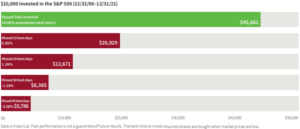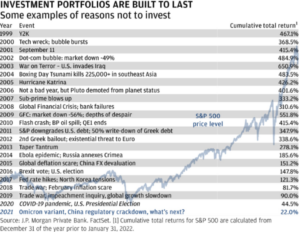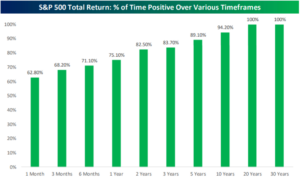“If a topic makes someone feel emotional, they will rarely be interested in the data. This is why emotions can be such a threat to wise decision making.” Herbert Simon, American political scientist
The allure of market timing is real.
Sell today. Stop the pain. Live to fight another day.
Sounds reasonable in theory. But, theory isn’t charged up with emotion.
We examine…
- Why market-timing is so difficult.
- The mindset of a market timer.
- What every market timer gets wrong.
- What you can do instead of marketing timing.
I define market timing as selling a large chunk of assets that would normally be invested because of the belief markets will head lower.
Why Market Timing is So Difficult
Empirical evidence would suggest missing out on the best return days can negatively impact returns.
Further, massive positive days come without notice or when things feel the worst.

Source: Putnam Investments
The above chart shows $10,000 invested in the S&P 500 from 12/31/2006 to 12/31/21 (green, fully invested, no market timing). Moving down the graphic, we can see how missing out on 10, 20, 30, and the 40 best return days drastically reduces the ending balance.
There are always going to be reasons to be skittish about financial markets. This is not a new phenomenon. Every decade has dealt with challenges, which often seem like obvious investment opportunities in hindsight.

Source: J.P. Morgan
The above graphic shows the S&P 500 (shaded line from 1999-2021), cumulative returns, along with reasons not to invest (or to sell). A pessimist could have a field day with this list of happenings, only to be left with dismal investment performance. For further reading, check out “Intoxicated with Pessimism.”
Zooming out, we can examine S&P 500 returns across various time frames. History has not been kind to those betting against higher stock prices.

Source: Bespoke Investment Group
The above graph shows the percentage of time the S&P 500 is positive over various time frames. In general, the longer the time frame, the higher likelihood of positive returns.
The Mindset of a Market-Timer
In my experience, the market timing mindset is a mix of the below cocktail…
The desire to enjoy the fruits of investing, but shun losses. Humans really hate losing money.
The investor understands the blood, sweat, and tears that went into building their nest egg. This creates an emotional attachment to the money, which is completely reasonable.
The market-timer thinks they can sell today to stop the pain and reinvest at lower prices tomorrow. It sounds like a rational plan, but falls apart virtually every time.
If the market goes up, the investor has missed out on gains. It’s really hard to stomach selling out and buying back at higher prices. This can lead to long periods of sitting on the sidelines while the market ascends higher.
If the market goes down, the original pessimistic disposition takes over. Things have to get worse. Let’s wait it out. The market eventually rebounds and the investor is left paralyzed by indecision.
Remember, there is no flashing neon sign that reads, “the bottom is in!” Nor is there an “All-Clear” investment signal.
What Every Market-Timer Gets Wrong
Market-timing is a two-part decision…
Selling (easy).
Buying back in (hard). This is where it’s almost certain to fall apart.
Ironically, we have argued in the past being “right” is the worst-case outcome for a market-timer.
From December 2020 “When Being Right is a Curse.” A personal friend was going to sell everything before the election…
Friend: “I think the market is going to tank after the election. I can buy back in after the sell-off.”
Nik: “I don’t think that’s a good idea, but not for the reasons you might think. The worst thing that could happen to you is being right.”
My friend just stared at me. Perplexed by my statement.
Nik: “If you’re right, you’ll likely make the same decision at some point down the line. You’ll be armed with false confidence. The stakes will likely be much higher as you get older.”
For my friend, being right would have been fool’s gold. He would likely set himself up for failure down the road. Not because he’s not a smart guy, but because he would be mistaking luck for skill.
What to do Instead of Market Timing
- Build a portfolio that mirrors the way you feel about risk. If you’re invested and the market tanks, that’s not the time to make a bunch of changes. Proper portfolio construction begins before something happens.
- Shade portfolio risk up or down, without making huge active bets. For example, instead of owning 60% stocks, someone looking to pare risk might own 45% stocks.
- If we get a steep market decline or recession, accept we will all feel some level of pain. Pivot your focus to mitigating damage.
- Ask for help. Money and investing can be emotional. If you’re prone to making impulsive decisions, there’s nothing wrong with engaging a professional advisor.
- Take a walk. Read a book. Call a friend. Breathe. Create space to think, reflect, and slow down.
Want to learn more about how Pure Portfolios mitigates human emotion in the investment process? Click here.
